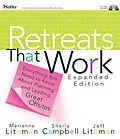Based on the best-selling first edition, this greatly expanded and updated version contains forty-seven new activities, more information about how to design and lead retreats, and additional suggestions for how to recover when things go wrong. A CD-ROM allows you to print out chapters for distribution to key leaders, duplicate templates, and produce handouts for specific exercises. Whether you're planning to lead an offsite retreat for the first time or the ninety-ninth time, this easy-to-use, one-stop resource provides: Step-by-step instructions for leading a wide variety of tested exercises. Insight into establishing effective working relationships with clients. Information on what to include in your retreat designs. Suggestions for encouraging participants to speak up and play an active role. Tools for managing conflict. Guidance on making decisions during a retreat and changing course when necessary. Strategies for developing and implementing action plans. Tips for follow-up so you can keep the change train on track. Order your copy of this practical guide today!
Autorentext
Merianne Liteman, Sheila Campbell, and Jeff Liteman consult to corporate, government, international organization, and nonprofit clients on strategic planning, strategic change, creative thinking, leadership development, and improved teamwork and communication.(You can find more information at www.retreatsthatwork.com.)
Inhalt
CD Contents.
Acknowledgments.
Introduction.
SECTION ONE: Materials for the Facilitator.
Chapter 1: Working with the Client.
Nine Reasons to Hold a Retreat.
Ten Reasons Not to Hold a Retreat.
What If the Client Is Your Boss?
Aligning Yourself with the Client.
Kinds of Retreats.
Using a Specialized Retreat Format.
Chapter 2: Planning the Retreat.
Pre-Retreat Interviews with Participants.
Identifying the Scope of Issues and Creating the Retreat Plan.
Who's Who in Planning a Retreat.
Involving Participants in Retreat Planning.
Deciding Whether to Work with a Co-Facilitator.
Thinking About Logistics.
Creating the Conditions for Success.
Chapter 3: Retreat Design Issues.
Sins of Omission: The Top Retreat Design Mistakes.
Prework for Retreat Participants.
Using White Space.
Capturing the Work Product.
Design Issues for a Series of Retreats.
Chapter 4: Retreat Design Components.
Introduction.
Ground Rules or Norms.
Individual Check-In.
Reporting Your Findings.
Content Segments.
Decision Making.
Action Planning.
Closing.
Post-Retreat Follow-Up.
The Importance of Timing.
Chapter 5: Structuring the Retreat.
Group Size and Composition.
Varying the Methodologies.
Incorporating Rituals.
Chapter 6: Leading the Retreat.
Key Facilitation Practices.
Encouraging Participation.
Process or Content Facilitator?
When Should the Facilitator Intervene?
Giving Feedback to Retreat Participants.
Co-Facilitation Challenges.
Diversity Issues.
Recording the Group's Work.
Monitoring the Group's Energy.
Changing the Plan.
Chapter 7: How to Recover When Things Go Awry.
A Few Participants Dominate the Discussions.
The Group Keeps Wandering off Task.
The Group's Energy Is Flagging.
A Participant Keeps Plowing the Same Ground.
A Participant Repeatedly Disrupts the Conversations.
The Participants Refuse to Deal with Important Issues.
A Senior Manager Violates the Ground Rules.
People Are Misusing Humor.
A Participant Is Overtly Hostile or Refuses to Participate.
I'm Outta Here: A Participant Walks Out.
A Participant Gets Furious or Defensive or Bursts into Tears.
Participants Are Turning the Retreat into a Gripe Session.
Participants Are Resisting New Ideas.
Activity: Gains and Losses.
An Intense Conflict Breaks Out.
A Participant Breaches Another's Confidence.
The Group Is Resisting You.
Chapter 8: Helping Participants Make Decisions and Plan for Action.
Methods of Decision Making.
Activity: Let's Take Our Chances.
Types of Retreat Decisions.
Activity: Our Stable of Clients or Resources.
Activity: Rating Resources.
Activity: Criteria Evaluation Grid.
Activity: Show Me Our Future.
The Nub: Action Planning.
Chapter 9: Leading a Strategic Planning Retreat.
Why Strategic Planning?
Elements of Organization Strategy.
Activity: Exploring Strategic Direction.
Activity: Prioritizing Constituencies.
Activity: Distinctive Competencies.
Activity: Our Proverbial Differentiation.
Activity: Sell Me Glamour.
Activity: Centers of Excellence.
Discerning the Organization's Values.
Activity: Values Vignettes.
Activity: Values Auction.
Understanding the Environment.
Activity: Glimpses into the Future.
Activity: Alternative Futures.
Evaluating Work Processes.
Planning for Action.
Activity: Targeting Results.
Checking Against Resources.
Activity: Resource/Impact Matrix.
Devising Strategies.
Testing Strategies.
Activity: Obstacle Busters I.
Writing the Plan 247
Chapter 10: Leading a Culture Change Retreat.
Great Expectations: What Can Realistically Be Accomplished at a Retreat.
Activity: Visit Our Village.
Activity: How We Behave.
Activity: Timeline of Our History.
Activity: Significant Stories.
Working with Sensitive or Controversial Issues.
Activity: Silent Dialogue.
Reward Structures Help Shape Culture.
Activity: What Gets Rewarded Here?
Activity: Reward Sonatas.
How Individuals Foster Culture Change.
Activity: We'll Keep . . . .
Recognizing and Removing Obstacles to Change.
Activity: Obstacle Busters II.
Feedback for Senior Executives.
Chapter 11: Leading a Team-Building Retreat.
If You're Asked to Lead a Team-Building Retreat.
Characteristics of a Produ...
